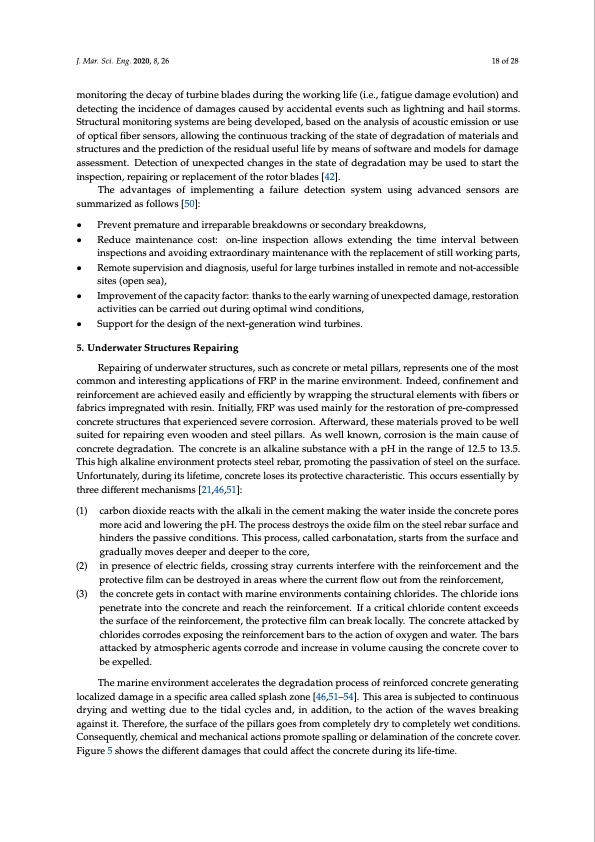
PDF Publication Title:
Text from PDF Page: 018
J. Mar. Sci. Eng. 2020, 8, 26 18 of 28 monitoring the decay of turbine blades during the working life (i.e., fatigue damage evolution) and detecting the incidence of damages caused by accidental events such as lightning and hail storms. Structural monitoring systems are being developed, based on the analysis of acoustic emission or use of optical fiber sensors, allowing the continuous tracking of the state of degradation of materials and structures and the prediction of the residual useful life by means of software and models for damage assessment. Detection of unexpected changes in the state of degradation may be used to start the inspection, repairing or replacement of the rotor blades [42]. The advantages of implementing a failure detection system using advanced sensors are summarized as follows [50]: • Prevent premature and irreparable breakdowns or secondary breakdowns, • Reduce maintenance cost: on-line inspection allows extending the time interval between inspections and avoiding extraordinary maintenance with the replacement of still working parts, • Remote supervision and diagnosis, useful for large turbines installed in remote and not-accessible sites (open sea), • Improvement of the capacity factor: thanks to the early warning of unexpected damage, restoration activities can be carried out during optimal wind conditions, • Support for the design of the next-generation wind turbines. 5. Underwater Structures Repairing Repairing of underwater structures, such as concrete or metal pillars, represents one of the most common and interesting applications of FRP in the marine environment. Indeed, confinement and reinforcement are achieved easily and efficiently by wrapping the structural elements with fibers or fabrics impregnated with resin. Initially, FRP was used mainly for the restoration of pre-compressed concrete structures that experienced severe corrosion. Afterward, these materials proved to be well suited for repairing even wooden and steel pillars. As well known, corrosion is the main cause of concrete degradation. The concrete is an alkaline substance with a pH in the range of 12.5 to 13.5. This high alkaline environment protects steel rebar, promoting the passivation of steel on the surface. Unfortunately, during its lifetime, concrete loses its protective characteristic. This occurs essentially by three different mechanisms [21,46,51]: (1) carbon dioxide reacts with the alkali in the cement making the water inside the concrete pores more acid and lowering the pH. The process destroys the oxide film on the steel rebar surface and hinders the passive conditions. This process, called carbonatation, starts from the surface and gradually moves deeper and deeper to the core, (2) in presence of electric fields, crossing stray currents interfere with the reinforcement and the protective film can be destroyed in areas where the current flow out from the reinforcement, (3) the concrete gets in contact with marine environments containing chlorides. The chloride ions penetrate into the concrete and reach the reinforcement. If a critical chloride content exceeds the surface of the reinforcement, the protective film can break locally. The concrete attacked by chlorides corrodes exposing the reinforcement bars to the action of oxygen and water. The bars attacked by atmospheric agents corrode and increase in volume causing the concrete cover to be expelled. The marine environment accelerates the degradation process of reinforced concrete generating localized damage in a specific area called splash zone [46,51–54]. This area is subjected to continuous drying and wetting due to the tidal cycles and, in addition, to the action of the waves breaking against it. Therefore, the surface of the pillars goes from completely dry to completely wet conditions. Consequently, chemical and mechanical actions promote spalling or delamination of the concrete cover. Figure 5 shows the different damages that could affect the concrete during its life-time.PDF Image | Marine Application of Fiber Reinforced Composites

PDF Search Title:
Marine Application of Fiber Reinforced CompositesOriginal File Name Searched:
jmse-08-00026.pdfDIY PDF Search: Google It | Yahoo | Bing
Development of a solar powered Electric Ship The Electricship website originally started off as a project to develop a comprehensive renewable, affordable, modular electric ship... More Info
Modular Boat Hull Composite The case for a unsinkable, modular composite hybrid boat hull... More Info
MS Burgenstock Hybrid Electric Catamaran Lake Lucerne Unique shuttle servicing Lucerne to the Burgenstock Resort... More Info
Ground Power Unit GPU Powered by Lithium Ion Batteries The goal of the Ground Power Unit is to provide a readily accessible, modular, ready-to-power solution for remote power... More Info
| CONTACT TEL: 608-238-6001 Email: greg@electricship.com | RSS | AMP |